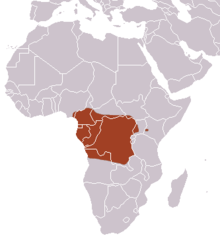Giant otter shrew
| Giant otter shrew | |
|---|---|
 |
|
| Scientific classification | |
| Kingdom: | Animalia |
| Phylum: | Chordata |
| Class: | Mammalia |
| Order: | Afrosoricida |
| Family: | Tenrecidae |
| Subfamily: | Potamogalinae |
| Genus: |
Potamogale Du Chaillu, 1860 |
| Species: | P. velox |
| Binomial name | |
|
Potamogale velox (Du Chaillu, 1860) |
|
 |
|
| Giant otter shrew range | |
The giant otter shrew (Potamogale velox) is a semiaquatic, carnivorous tenrec. It is found in the main rainforest block of central Africa from Nigeria to Zambia, with a few isolated populations in Kenya and Uganda. It is found in streams, wetlands and slow flowing larger rivers. It is monotypic in the genus Potamogale.
Contrary to its name the giant otter shrew is not a true shrew (Soricidae) but a tenrec (Tenrecidae). The common name refers to their resemblance to otters with their flat face and stiff whiskers, and the tenrecs' overall superficial similarity to true shrews. They are nocturnal carnivores that feed on aquatic animals.
The giant otter shrew is a mammal superficially similar to an otter in appearance. It is characterized by a long, flat tail, which it uses for swimming by sideways undulation like a fish. It has a muzzle covered with bristles, and flat shielded nostrils. It has dense, soft hair, silky on the tail.
It has small eyes and external ears. Its fur consists of a dense undercoat and coarse guard hairs. It possesses counter-shading with dark brown on its back and whitish or yellowish under parts. The tail is covered with a short, silky coat of fur and is compressed laterally which allow it to swim by horizontal undulations as in fishes and crocodiles. Its legs are short and lack webbing so they are not used for swimming. The hind feet have a flap of skin along the inside that allows them to be held snugly against the body when swimming. There are also two syndactylous (2nd and 3rd toes are fused) toes on the hind feet, used for grooming. On land P. velox is plantigrade. Females have two mammae on the lower abdomen for feeding young.
...
Wikipedia

